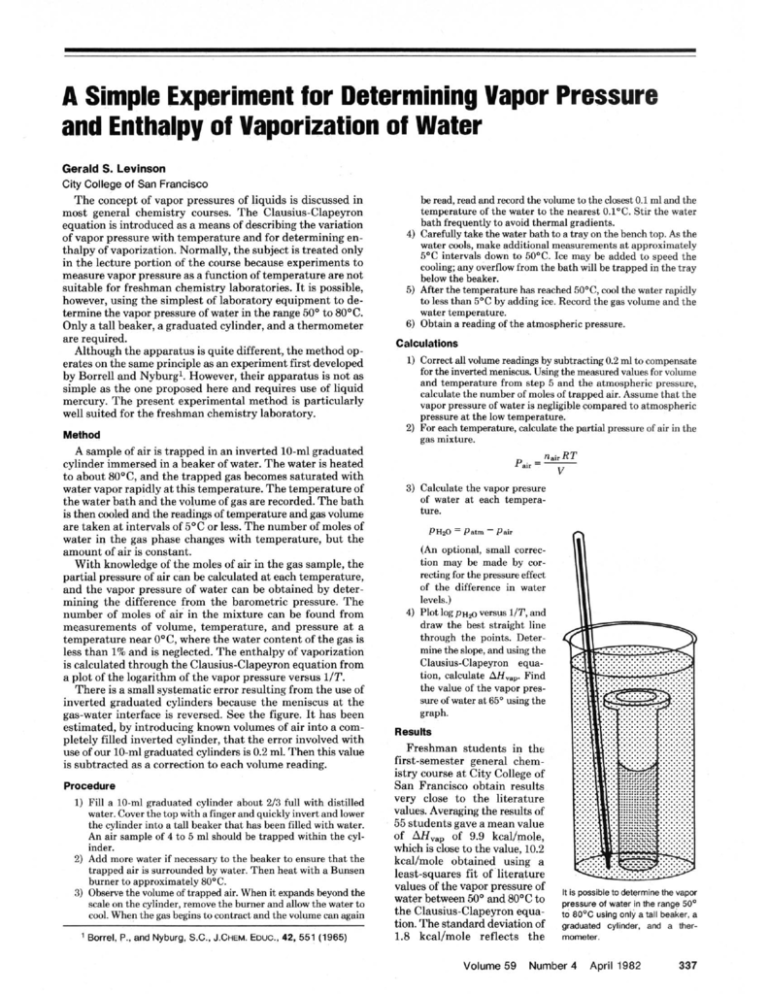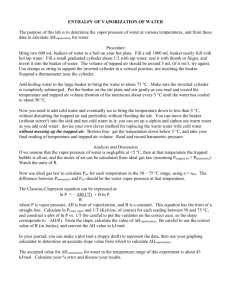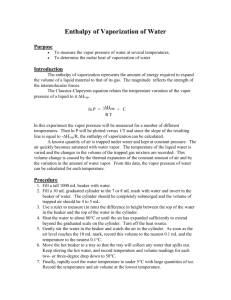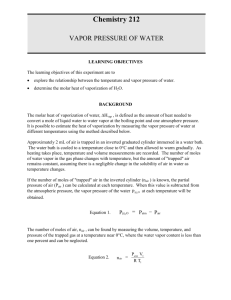A simple experiment for determining vapor pressure and enthalpy of
advertisement

A Simple Experiment for Determining Vapor Pressure and Enthalpy of Vaporization of Water Gerald S. Levinson City College of San Francisco The concept of vapor pressures of liquids is discussed in most general chemistry courses. T h e Clausius-Clapeyron equation is introduced as a means of describing the variation of vapor pressure with temperature and for determining euthalpy of vaporization. Normally, the subject is treated only in the lecture portion of the course because experiments to measure vapor pressure as a function of temperature are not suitable for freshman chemistry laboratories. It is possible, however, using the simplest of laboratory equipment to determine the vapor pressure of water in the range 50° to 80PC. Only a tall beaker, a graduated cylinder, and a thermometer are required. Although the apparatus is quite different, the method operates on the same principle as an experiment fmt developed by Borrell and Nyburgl. However, their apparatus is not as simple as the one proposed here and requires use of liquid mercury. T h e present experimental method is particularly well suited for the freshman chemistry laboratory. Method A sample of air is trapped in a n inverted 10-ml graduated cylinder immersed in a beaker of water. T h e water is heated to about 80°C. and the trapped gas becomes saturated with water vapor rapidly a t this temperature. The temperature of the water bath and the volume of gas are recorded. T h e bath is then cooled and the readings of temperature and gas volume are taken a t intervals of 5°C or less. The number of moles of water in the gas phase changes with temperature, hut the amount of air is constant. With knowledge of the moles of air in the gas sample, the partial pressure of air can be calculated a t each temperature, and the vapor pressure of water can be obtained by determining the difference from the barometric pressure. T h e numher of moles of air in the mixture can be found from measurements of volume, temperature, and pressure a t a temperature near O0C, where the water content of the gas is less than 1% and is neglected. The enthalpy of vaporization is calculated through the Clausius-Clapeyron equation from a plot of the logarithm of the vapor pressure versus 11T. There is a small systematic error resulting from the use of inverted graduated cylinders because the meniscus a t the gas-water interface is reversed. See the figure. It has been estimated, by introducing known volumes of air into a completely filled inverted cylinder, that the error involved with use of our 10-ml graduated cylinders is 0.2 ml. Then this value is subtracted as a correction to each volume reading. Procedure 1) Fill a 10-ml graduated cylinder about 213 full with distilled water. Cover the top with a finger and quickly invert and lower the cylinder into a tall beaker that has been filled with water. An air sample of 4 to 5 ml should be trapped within the cylinder. 2) Add more water if necessary to the beaker to ensure that the trapped air is surrounded by water. Then heat with a Bunsen burner to approximately 80°C. 3) Observe the volume of trapped air. When it expands beyond the scale on the cylinder, remove the burner and allow the water to cool. When the gas begins to contract and the volume can again ' Borrel, P., and Nyburg, S.C., J.CHEM.Ewc., 42, 551 (1965) he read, read and m r d the volume ta the closest 0.1 ml and the temperature of the water to the nearest 0.1%. Stir the water bath frequentlyto avoid thermal gradients. 4) Carefully take the water bath to a tray on the bench top. As the water cools, make additional measurements at approximately 5OC intervals down to 50°C. Ice may be added to speed the cooling; any overflow from the bath will be trapped in the tray below the heaker. 5 ) After rhr temperature h i ~ reached s 50°V, crud the watrr rapidly to less than S°C by adding ire. Record the gas volume and the water temperature. 6) Obtain a reading of the atmospheric pressure. Calculatlons 1) Correct all volume readings by subtracting 0.2 ml to compensate for We inverted meniscus. Using the measured values for volume and temperature from step 5 and the atmospheric pressure, calculate the number of moles of traooed .. air. Assume that the vaoor of water is neelieihle . oressure . .. ,. comoared to atmosnheric pressure at the low temperature. 2) For each trmprature, calculate the pmial pressure 01 air in the gas mixture. ~ pa, = ~ .~ ~ ~ e v 3) Calculate the vapor presure of water st each temperature. (An optional, small correction may he made by correcting for the pressure effect of the difference in water levels.) 4) Plot log PH* versus 1IT. and draw the hest straight line through the points. Determine the slope, and using the Clausius-Clapeyron equaFind tion, calculate AH., the value of the vapor pressure of water at 65' using the graph. Results Freshman students in the first-semester general chemistry course A t City College of Sau Francisco obtain results very close to the literature values. Averaging the results of 55 students gave a mean value of 9.9 kcallmole, of AH,, which is close to the value, 10.2 kcallmole obtained using a least-squares fit of literature values nf the vapor pressure of water between 50' and HO°C to the Clausius-Claoevron eauation. The standard cieviation of 1.8 kcallmole reflects the Volume 59 it is possible to determine the vspw pressure of water in the range 50' 1680°C using only a tail beaker, a graduated cylinder. and a thermometer. Number 4 April 1982 337 experimental uncertainties in readings plus plotting and drawing the best line through experimental points. The average value of the vapor pressure a t 65O read from the graph was 188.4 torr, a value in excellent agreement with the handbook value of 187.5 torr, hut the standard deviation of 44 torr shows a rather wide scatter in the results. An examination of the students' data showed that about half the scatter, as measured by both the standard deviations given above, resulted from the imprecise graphing procedures of freshman students who have had only limited experience in estimating best lines through data points. Several refinements are possible to extend or improve the experiment, while still maintaining simplicity. Accuracy and 338 Journal of Chemical Education precision of the volume readings could be improved by suhstituting a gas measuring tube for the graduated cylinder. The extrapolation procedure of Borrell and Nyburg could be used to establish that the vapor pressure of water is indeed negligible around 5°C. Acknowledgment The method of determining the correction for the inverted meniscus was devised and carried out by the late Thomas M. Hynes of the Chemistry Department a t City College of San Francisco.









